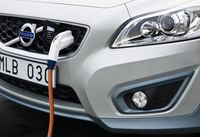Volvo Takes on Safety Challenges of Electric Cars
SEE ALSO:http://www.ev-motoring.com"> EV-Motoring - Electric Vehicle News Specs and Reviews
SYDNEY – January 12, 2010: A battery-powered Volvo must be as safe as any other new Volvo model, which is why Volvo Cars' work on electrification technology includes a systematic approach to safety issues related to battery power.
"We apply the same high safety standards to all our products but the safety-related challenges may differ depending on the driveline and fuel being used. To us, electrification technology is another exciting challenge in our quest to build the safest cars on the market," says Volvo Cars' safety expert Thomas Broberg.
"It is understandable that a lot of questions about electrification safety are related to what will happen in an accident. But considering that less than one percent of our cars are involved in an accident during their life on the roads, we must adopt a more holistic approach, including all the aspects of day-to-day usage of the car," added Thomas Broberg.
Monitoring and encapsulation
Volvo is currently conducting
wide-ranging and thorough analysis of a variety of safety scenarios for
cars with electric power. Through advanced automatic monitoring of battery
status and by encapsulating the battery and protecting it effectively in a
collision, the result is a comprehensive safety package of the very highest
class.
"A holistic approach and real-life traffic conditions are always the starting-point for our safety work. Based on our massive database with input from actual road accidents, we know where the focus must lie in everyday traffic conditions. The solutions we have developed for our forthcoming electric cars therefore take into account the situations that are unique to this type of car," says Thomas Broberg.
Everything from the way the cars are produced, used and serviced to the way they are recycled is analysed thoroughly and the information obtained is used to shape the development of the final production car.
Comprehensive testing under way - and there's more on the
way
Volvo's safety tests take place in several different stages.
First at component level, then for whole systems and finally the complete
car is safety-tested virtually via computer, and physically in Volvo's
technically advanced crash-test centre.
"At present we are conducting tests at component level to see how the battery is affected by harsh braking and the subsequent collision. We are examining the results from several different angles. We have also carried out, for the first time, advanced full-scale crash tests to evaluate the technology used in electrically powered cars," reveals Thomas Broberg.
Volvo is using its unique know-how from actual traffic conditions to carry out detailed testing and verification. What is more, the test regime includes the general requirements and protocols of the industry's safety institutes.
When Volvo analyses traffic situations from a safety perspective, the engineers use a model that illustrates the sequence of events during the whole driving phase. The process is divided into five phases: from the normal driving situation to after the accident has occurred. Based on these five phases, Volvo develops new safety solutions and improves existing ones.
Unique solutions for electric cars
All Volvo's existing safety
systems will also be available in the company's electric cars. However,
electric power also adds new possible safety scenarios to the overall
picture and these too must be addressed.
Volvo's safety experts have meticulously analysed the five accident sequence phases and developed unique solutions for the battery and for protection of the occupants as necessary.



